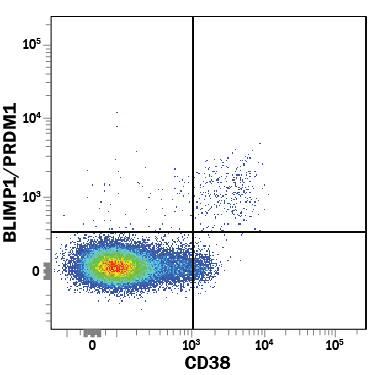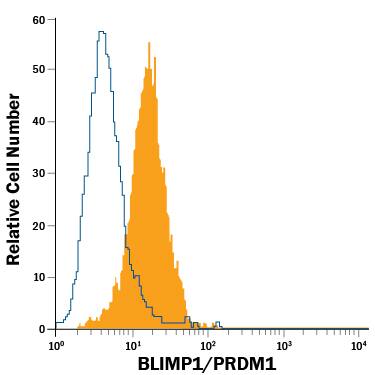Human BLIMP1/PRDM1 PE-conjugated Antibody
R&D Systems, part of Bio-Techne | Catalog # IC36081P


Key Product Details
Species Reactivity
Validated:
Cited:
Applications
Validated:
Cited:
Label
Antibody Source
Product Specifications
Immunogen
Lys667-Cys789
Accession # O75626
Specificity
Clonality
Host
Isotype
Scientific Data Images for Human BLIMP1/PRDM1 PE-conjugated Antibody
Detection of BLIMP1/PRDM1 in Human PBMCs by Flow Cytometry.
Human peripheral blood mononuclear cells (PBMCs) gated on CD19+CD3-cells were stained with Mouse Anti-Human BLIMP1/PRDM1 PE-conjugated Monoclonal Antibody (Catalog # IC36081P) and Mouse Anti-Human CD38 PerCP-conjugated Monoclonal Antibody (Catalog # FAB2404C). To facilitate intracellular staining, cells were fixed with Flow Cytometry Fixation Buffer (Catalog # FC004) and permeabilized with Flow Cytometry Permeabilization/Wash Buffer I (Catalog # FC005). View our protocol for Staining Intracellular Molecules.Detection of BLIMP1/PRDM1 in U266 Human Cell Line by Flow Cytometry.
U266 human myeloma cell line was stained with Mouse Anti-Human BLIMP1/PRDM1 PE-conjugated Monoclonal Antibody (Catalog # IC36081P, filled histogram) or isotype control antibody (Catalog # IC002P, open histogram). To facilitate intracellular staining, cells were fixed with Flow Cytometry Fixation Buffer (Catalog # FC004) and permeabilized with Flow Cytometry Permeabilization/Wash Buffer I (Catalog # FC005). View our protocol for Staining Intracellular Molecules.Applications for Human BLIMP1/PRDM1 PE-conjugated Antibody
Intracellular Staining by Flow Cytometry
Sample: U266 human myeloma cell line and human peripheral blood mononuclear cells (PBMCs) gated on CD19+CD3- cells fixed with Flow Cytometry Fixation Buffer (Catalog # FC004) and permeabilized with Flow Cytometry Permeabilization/Wash Buffer I (Catalog # FC005). View our protocol for Staining Intracellular Molecules.
Formulation, Preparation, and Storage
Purification
Formulation
Shipping
Stability & Storage
Background: BLIMP1/PRDM1
Human BLIMP1 (B lymphocyte-induced maturation protein 1, also known as PRDM1) is a 91 kDa zinc-finger transcriptional repressor that promotes B cell maturation into plasma cells. It is 789 amino acids (aa) in length, and contains an N-terminal S-E-T domain (aa 64-170) and four C-terminal C2H2-type zinc-finger motifs (aa 539‑645). The SET domain interacts with chromatin modifers, while the zinc fingers bind to DNA. There is one 80 kDa, 691 aa alternate splice form that utilizes an intenal start site. This results in a substitution of three aa for the first 101 aa of the long form, and the loss of the SET domain. At least 10 mutations exist, resulting in proteins of 61‑603 aa in length. Over aa 667-789, human BLIMP1 is 89% aa identical to mouse BLIMP1.
Long Name
Alternate Names
Gene Symbol
UniProt
Additional BLIMP1/PRDM1 Products
Product Documents for Human BLIMP1/PRDM1 PE-conjugated Antibody
Product Specific Notices for Human BLIMP1/PRDM1 PE-conjugated Antibody
For research use only
